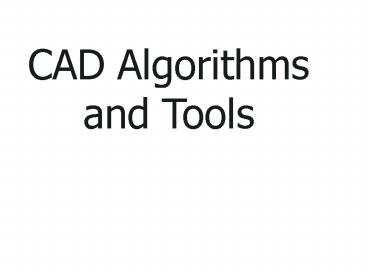Applications of Binary Decision Diagrams in Logic Synthesis, Verification, and Testing - PowerPoint PPT Presentation
Title:
Applications of Binary Decision Diagrams in Logic Synthesis, Verification, and Testing
Description:
Title: Applications of Binary Decision Diagrams in Logic Synthesis, Verification, and Testing Author: Karen R. Steingart Last modified by: Marek Created Date – PowerPoint PPT presentation
Number of Views:102
Avg rating:3.0/5.0
Title: Applications of Binary Decision Diagrams in Logic Synthesis, Verification, and Testing
1
CAD Algorithms and Tools
2
Overview
- Introduction
- Multi-level logic synthesis
- SIS as a representative CAD tool
- Boolean networks
- Transformations of Boolean networks
- sweep, eliminate, fast_extract, resub,
full_simplify - Optimization loop
- Implementation
- network/node data structure, packages, scripts
- Conclusions
- Software demo
3
Introduction
- Multi-level logic synthesis
- Description, motivation, results
- Logic synthesis methods
- In the past, applied by hand now, by the tools
- CAD tools
- Experimental, industrial
4
SIS
- The first comprehensive open-source logic
synthesis tool - Based on a decade of research at UC Berkeley and
other universities (1983-1993) - Precursor of many modern CAD tools
- Gives a good idea what is inside those tools
- Source code, benchmarks available on-line
- http//www-cad.eecs.berkeley.edu/Software/software
.html
5
Boolean Networks
- Boolean network is a direct acyclic graph
Primary inputs (PIs)
Primary outputs (POs)
Internal nodes
6
Fanin/Fanout of a Node
- Node has only one output.
- Node can have any number of inputs (fanins)
- and can be an input to any number of nodes
(fanouts)
FO1
FO2
FO3
Fanouts
N
Node
FI2
FI3
FI1
Fanins
7
Transitive Fanin/Fanout of a Node
Transitive fanout
Transitive fanin
N
8
Factoring
Optimizing Transformations on Boolean Networks
- F ac ad bc bd e
- ?
- F (ab)(cd) e
9
Common logic extraction
- F (a b)cd e F XY e
- G (a b)e ? G Xe
- H cde H Ye
- X a
b - Y cd
F
G
H
G
H
F
X
Y
10
Resubstitution
- G a b c G a b c
- F a bd cd ? F G(ad)
F
F
G
G
11
Elimination
- G a b c G a b c
- F G(ad) ? F a bd cd
F
F
G
G
12
Sweep
- Removes nodes that do not fanout
- Eliminates constant nodes and single-input nodes
(buffers, inverters)
13
full_simplify
- Simplifies each node in the network using
dont-cares
14
Dont-cares for Nodes in the Network
- External dont-cares
- Some input combinations never occur (unused
codes, unreachable states) - Internal dont-cares
- Satisfiability dont-cares
- Some input combinations never occur at a node
- Observability dont-cares
- Under some input combinations, the value produced
at the output of the node does not matter
15
Satisfiability Dont-cares
- (x,y)(1,0) is a dont-care for node F
x
a
z1
F
b
y
c
16
Observability Dont-Cares
- (a,c)(1,1) is a dont-care for node F
a
z1
F
b
z2
c
17
node_struct
Role of sophisticated representations, data
structures and algorithms.
Structure of a node
- struct node_struct
- char name / name of the output signal /
- char short_name / short name for
interactive use / - node_type_t type / type of the node /
- int sis_id / unique id (used to sort
fanin) / - unsigned fanin_changed1 / flag to catch
fanin generation errors / - unsigned fanout_changed1 / flag to catch
fanout generation errors / - unsigned is_dup_free1 / node has no
aliasing of its fanin / - unsigned is_min_base1 / node is minimum
base / - unsigned is_scc_minimal1 / node is
scc-minimal /
18
node_struct (continued)
- int nin / number of inputs /
- node_t fanin / the array of pointers to
the input nodes / - lsList fanout / list of 'fanout_t'
structures / - lsHandle fanin_fanout / handles of our
fanin's fanout_t structure / - pset_family F / on-set /
- pset_family D / dc-set -- currently unused
/ - pset_family R / off-set /
- node_t copy / used by network_dup(),
network_append() / - network_t network / network this node
belongs to / - lsHandle net_handle / handle inside of
network nodelist /
19
network_struct
Structure of a network
- struct network_struct
- char net_name / the name of the network
/ - st_table name_table / table to hash names
into node pointers / - st_table short_name_table / table to hash
names into node pointers / - lsList nodes / list of all nodes /
- lsList pi / list of just primary inputs
/ - lsList po / list of just primary outputs
/ - network_t dc_network / external
don't care network / - st_table latch_table / table to
hash names into latch pointers / - lsList latch / the linked
list of latches / - graph_t stg / state
transition graph / - char clock / the clock /
- char default_delay / stores default delay
info / - astg_t astg / asynchronous signal
transition graph /
20
script.rugged
Role of scripting and user-directed synthesis
- sweep eliminate -1
- simplify -m nocomp
- eliminate -1
- sweep eliminate 5
- simplify -m nocomp
- resub -a
- fx
- resub -a sweep
- eliminate -1 sweep
- full_simplify -m nocomp
Scripts to control the synthesis process
21
Whats next?
- Multi-valued logic optimization
- New CAD tool MVSIS
- Reversible logic synthesis
- Quantum, DNA-based, etc
22
full_simplify SIS vs. MVSIS
23
Conclusions
- Reviewed multi-level logic optimization
- Introduced Boolean networks
- Considered typical operations
- Looked into the implementation of SIS
24
Problems for students
- What are BDDs and how are they used.
- Shannon expansion and its role in trees and
diagrams - Boolean networks
- Operations on Boolean Networks.
- Various types of dont cares and their use
- SIS system in practice.
25
Sources Alan Mishchenko Electrical and
Computer Engineering Portland State University































